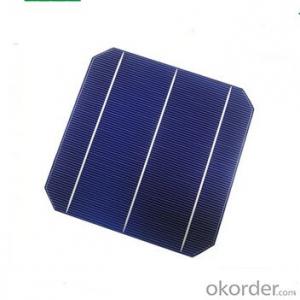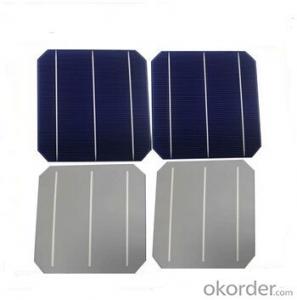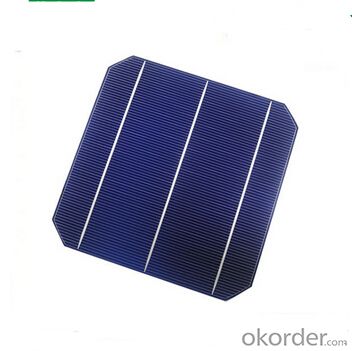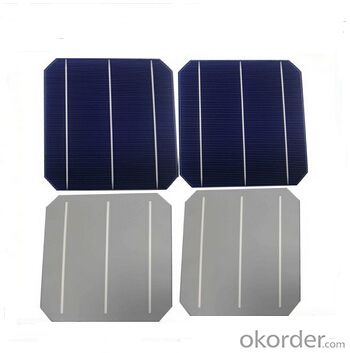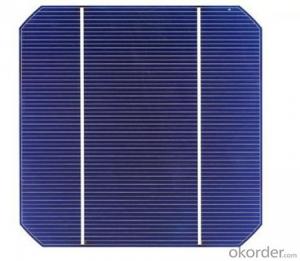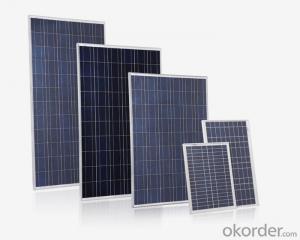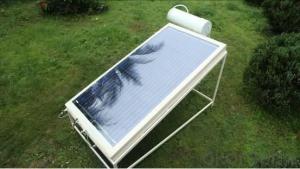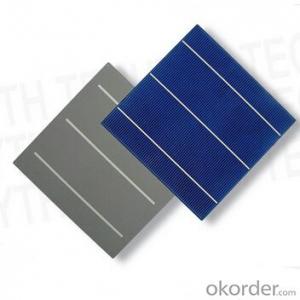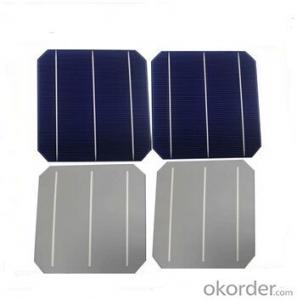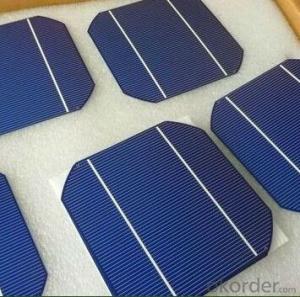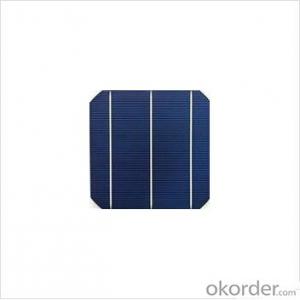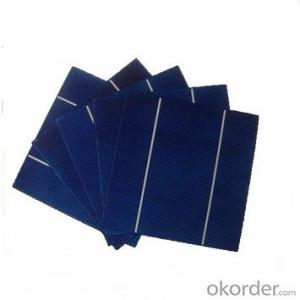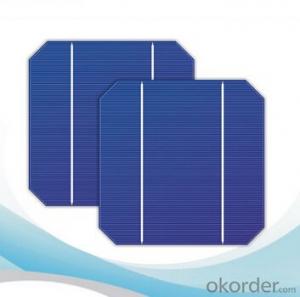Untabbed Monocrystalline Solar Cells High Quality 17.20
- Loading Port:
- Shanghai
- Payment Terms:
- TT OR LC
- Min Order Qty:
- 1000 pc
- Supply Capability:
- 100000 pc/month
OKorder Service Pledge
OKorder Financial Service
You Might Also Like
Solar Cells:
Solar cells is made by solar wafer, it has three categories of solar cell right now, monocrystalline polycrystalline and thin film,These cells are entirely based around the concept PN junction, which is the critical part of solar module, it is the part that can convert the light energy into electricity, the thickness is from 180um to 200um, with even busbars to conduct electricity, textured cell can decrease diffuse reflection; they are often electrically connected and encapsulated as a module. Photovoltaic modules often have a sheet of glass on the front (sun up) side, allowing light to pass while protecting semiconductor wafers from abrasion and impact due to wind-driven debris, rain, hail, etc. Solar cells are also usually connected in series in modules, creating an additive voltage. Connecting cells in parallel will yield a higher current;With high quality and stable quality. Our Cells can greatly improve the performance of Solar Modules.
Solar Cells Advantage:
• High efficiency and stable performance in photovoltaic conversion.
• Advanced diffusion technique ensuring the homogeneity of energy conversion efficiency of the cell.
• Advanced PECVD film forming, providing a dark blue silicon nitride anti-reflection film of homogenous color and attractive appearance.
• High quality metal paste for back surface and electrode, ensuring good conductivity, high pulling strength and ease of soldering.
• High precision patterning using screen printing, ensuring accurate busbar location for ease with automatic soldering a laser cutting.
Specifications:
Dimensions | 156x156 mm |
Diagonal | 220 mm |
Cell Thickness | 180/200 ± 20μm |
Front | Blue silicon nitride anti-reflective coatings |
3x1.5mm silver busbar | |
Back | Full-surface aluminum back-surface field |
3x3.0mm (silver/aluminum) discontinuous soldering pads |
Electrical Characteristics | ||||||
Efficiency code | Efficiency Eff(%) | Power Pmax(W) | Max.Power Current Ipm(A) | Short Circuit Current Isc(A) | Max.Power Voltage Vpm(V) | Open Circuit Voltage Voc(V) |
1760 | 17.60 | 4.28 | 8.097 | 8.561 | 0.529 | 0.631 |
1740 | 17.40 | 4.23 | 8.035 | 8.506 | 0.527 | 0.629 |
1720 | 17.20 | 4.19 | 7.973 | 8.454 | 0.525 | 0.627 |
1700 | 17.00 | 4.14 | 7.910 | 8.398 | 0.523 | 0.625 |
1680 | 16.80 | 4.09 | 7.847 | 8.335 | 0.521 | 0.623 |
1660 | 16.60 | 4.04 | 7.769 | 8.267 | 0.520 | 0.622 |
1640 | 16.40 | 3.99 | 7.690 | 8.203 | 0.519 | 0.621 |
Packaging & Delivery of Solar Cells
Carton Box Package and Deliver by air. It should be noticed that it should be avoid of water, sunshine and moist.
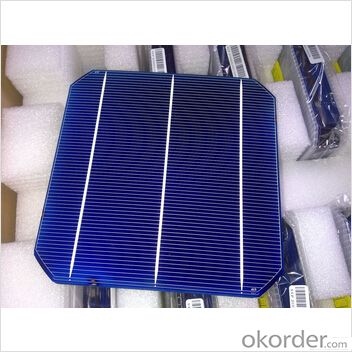
FAQ
We have organized several common questions for our clients,may help you sincerely:
①What price for each watt?
It depends on the efficiency of the solar cell, quantity, delivery date and payment terms.
②How long can we receive the product after purchase?
In the purchase of product within three working days, We will arrange the factory delivery as soon as possible. The pecific time of receiving is related to the state and position of customers.Commonly 7 to 10 working days can be served.
③Can you provide the peripheral products of the solar panels, such as the battery, controller, and inverter? If so, can you tell me how do they match each other?
Yes, we can, we have two companies for solar region, one is CNBM International, the other is CNBM engineering Co.
We can provide you not only the solar module but also the off grid solar system, we can also provide you service with on grid plant.
④What is your warranty of solar cell?
Our product can promise lower than 0.3% open box crack, we support claim after opening the box if it has crackm color difference or sth, the buyer should give pictures immediately, we can not accept the claim after the solar cell has assembled to solar panel.
• Timeliness of delivery
• ⑤How do you pack your products?
We have rich experience on how to pack the solar cell to make sure the safety on shipment, we could use wooden box or pallet as buyer's preference.
- Q: What is the role of junction boxes in solar cell systems?
- Junction boxes in solar cell systems serve as important components that provide electrical connections and protection for the wiring and components within the system. They are responsible for housing the electrical connections between solar panels, inverters, and other electrical devices, ensuring proper flow and distribution of electricity. Additionally, junction boxes help regulate the temperature and prevent moisture or debris from entering the system, ensuring the safety and efficiency of the solar cell system.
- Q: Can solar cells be used in emergency lighting?
- Yes, solar cells can be used in emergency lighting. Solar cells are capable of converting sunlight into electrical energy, which can be stored in batteries for later use. This makes them a reliable and sustainable option for emergency lighting, as they can provide power during power outages or in remote areas where traditional electricity sources may not be available.
- Q: Can solar cells be used in schools or educational institutions?
- Yes, solar cells can definitely be used in schools or educational institutions. In fact, they are increasingly being adopted by educational institutions as a way to provide clean and sustainable energy. Solar cells can be installed on rooftops or open spaces in schools to generate electricity, reducing dependency on traditional sources and saving on energy costs. Moreover, incorporating solar cells into the curriculum can also provide students with hands-on learning opportunities about renewable energy and sustainability.
- Q: Can solar cells be used to power an entire household?
- Yes, solar cells can be used to power an entire household. With advancements in solar technology and proper installation, a solar power system can generate enough electricity to meet the energy needs of a household, especially when combined with energy storage solutions. However, the feasibility and effectiveness of using solar cells to power an entire household depend on various factors such as the size of the solar system, energy consumption patterns, geographic location, and available sunlight.
- Q: Can solar cells be used for disaster relief efforts?
- Yes, solar cells can be used for disaster relief efforts. They provide a reliable source of clean energy, which can be crucial in situations where traditional power sources are disrupted or unavailable. Solar cells can be used to power emergency communication systems, medical equipment, lighting, and water purification systems, among other essential needs in disaster-stricken areas. Additionally, portable solar panels can be easily deployed to remote locations, making them an ideal solution for providing immediate power during relief operations.
- Q: What is the impact of dust and dirt on solar cell efficiency?
- Dust and dirt can have a significant impact on solar cell efficiency. When dust and dirt accumulate on the surface of solar cells, they block sunlight from reaching the cells, reducing their ability to generate electricity. This decrease in solar cell efficiency can lead to a decrease in overall power output and, consequently, a decrease in the overall efficiency of a solar panel or system. Regular cleaning and maintenance of solar panels are necessary to ensure optimal performance and maximize energy production.
- Q: Can solar cells be used for powering electric fences?
- Yes, solar cells can be used for powering electric fences. Solar cells convert sunlight into electrical energy, which can be stored in batteries and used to power electric fences. This provides a sustainable and environmentally-friendly solution for powering fences in areas where access to grid electricity is limited or expensive.
- Q: Can solar cells be used to power refrigeration systems?
- Yes, solar cells can be used to power refrigeration systems. Solar cells convert sunlight into electricity, which can then be used to power various appliances, including refrigeration systems. This is particularly useful in off-grid or remote areas where access to conventional power sources may be limited.
- Q: Can solar cells be used for large-scale power generation?
- Yes, solar cells can certainly be used for large-scale power generation. They have the potential to harness abundant sunlight and convert it into electricity on a massive scale. As technology and efficiency of solar cells continue to improve, they are increasingly being deployed in utility-scale solar farms, providing a sustainable and renewable source of power to meet the growing energy demands of our society.
- Q: What is the role of solar cells in powering electric vehicles?
- Solar cells play a crucial role in powering electric vehicles by converting sunlight into electricity. These cells are typically mounted on the roof or body of the vehicle, absorbing sunlight and generating electrical energy. This energy is then used to charge the electric vehicle's battery, providing an additional source of power and extending its range. Although solar cells alone may not be sufficient to fully power an electric vehicle, they help reduce reliance on traditional charging methods and promote sustainable and renewable energy usage.
Send your message to us
Untabbed Monocrystalline Solar Cells High Quality 17.20
- Loading Port:
- Shanghai
- Payment Terms:
- TT OR LC
- Min Order Qty:
- 1000 pc
- Supply Capability:
- 100000 pc/month
OKorder Service Pledge
OKorder Financial Service
Similar products
Hot products
Hot Searches
Related keywords
